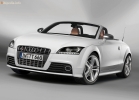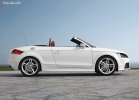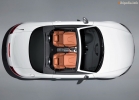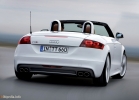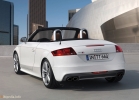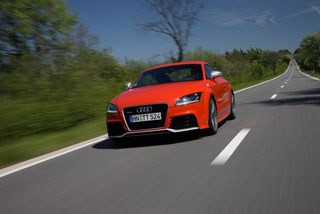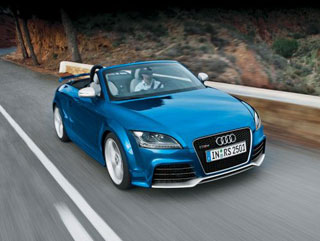Audi TTS Roadster test drive since 2008.
Fighter
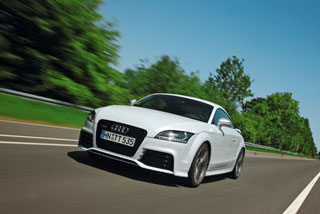 Comparisons of Audi TT with the Tula Tokarev pistol are understandable, but not relevant. The TT RS version was associated with us exclusively with a fighter in a shock flight
Comparisons of Audi TT with the Tula Tokarev pistol are understandable, but not relevant. The TT RS version was associated with us exclusively with a fighter in a shock flight Attractive streamlined forms, a compact muscular case, a narrowed, low profile, spectacular aerodynamic elements, a powerful engine and a tightly knocked down structure. These qualities are distinguished by Audi TT RS with classic fighters of the Second World War. Short -winged and short -fuel military aircraft of those times were often called flying engines. Almost a paradox: when engineers put at the forefront of speed and maneuverability, they got works of art, to this day exhibiting in museums.
Of course, aviation style is manifested in TT RS implicitly. The company from Ingolstadt does not have a flight genealogy, like BMW, Saab or Subaru, but the spirit of the fighter in the Audi TT RS is present. Like the sports car voyage. This is emphasized by a sports car, approaching the dynamic indicators to supercars. But this is also obvious an image model, captivating the civilian aesthetics of circus circles and semicircle. Not surprising. The design of the 1998 TT design is the work of Freeman Thomas, at that time the chief designer of the California Design Center VW-Audi. The American was also painted by the famous VW Concept 1, which later became an icon of Neo -Ooretro, VW New Beetle. Should it be surprised that TT RS also sounds retrontete?
Be that as it may, the appearance of TT turned out to be classic and organic. So much so that the team of the current chef Walter da Silva decided with a redesign only for easy correction. The second -generation Tapeshka added a premium gloss. The main element of Anfas was the Single Frame radiator grille. Large air intakes emphasized the potential of the engines. The headlights narrowed, sharpened and covered with LEDs. The TT RS modification has acquired a fixed rear anti -winged and the original apron of the front bumper.
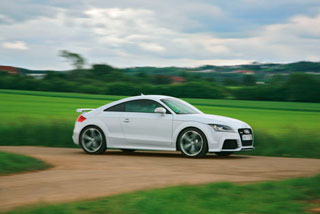 Attack on the receptors
Attack on the receptors Like any image product, TT RS affects the main senses of a potential consumer. It is not surprising that the most Erask excites visual receptors. The catchy color attracts no less than seductive forms. There are few options here, and this is indicative. In addition to exotic blue and gray metallic, red, white, silver and black are most in demand. No green or even more brown shades! TT RS external mirrors are standardly decorated with matte aluminum. The lid of the gas tank is also invariably silver. This is a bright sports accent - the same as aluminum and metal overlays on the steering wheel, the central console, the μP lever, pedals and internal door handles.
The touch organs respond to TT RS no less acutely. The power of the car can already be felt when opening its massive door and stepping over the same massive threshold. The inconvenience of planting and enthusiasm only enhances the perception of Erasa as a stylish sports car. In a squat compartment you climb like a fighter’s cab. We have to bend and look for the points of the support. To get out of the rear seat is even problematic, especially with the front armchair pushed back. The rear sofa here is ephemeral. You can sit there only in Turkish, a minimum place. People talked above the average will earn their heads in the ceiling. But the paradox is that this tightness is not annoying. Rather, on the contrary, the fighting character of the car emphasizes. In addition, there are more than enough places on the front seats, especially in the shoulders and above the head.
Sound. He should also be said separately. The only TT RS 2.5-liter 340-horsepower TFSI for the version manifests itself differently. In standard mode, the car sniffs delicately, without switching to increased tones. However, it is worth pressing the Sport key on the central tunnel, and Erask will give a completely different voice. In the left pipe of the exhaust system, the damper will open, and the release will sound saturatedly and aggressively, in rally tonality. Of course, such a roar is not a props. At the same time, the engine reaction to the gas pedal is exacerbated. And in the case of equipping the car, the adaptive system for adjusting the Audi Magnetic Ride shock absorbers becomes more clamped.
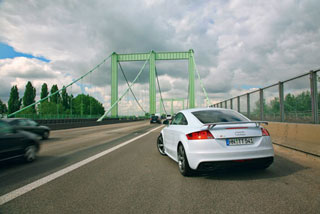 By screws!
By screws! The first impressions of staying in TT RS are almost entirely positive. Articles about other modifications of Teteshka with its supposedly terrible review through the gaps of lateral glasses, about the dental suspension and an unlocked adhesion pedal surge. So I want to shout to the authors: die imagination! After adjusting the chair in height, even the slightest claims to the review did not arise. Compact dimensions and short overhangs turned maneuvering into pleasure. Killers are convenient and play the role of a nationwide shirt on turns. A chubby steering wheel with a beveled lower part will make life easier for tall drivers, but not too convenient when you have to twist it quickly and stop it all the way. Hands are bumped into unevenness, and there is a feeling of light panic.
Small speeds TT RS are not what does not like, but rather contemptuously ignores. When moving in a traffic jam, it is necessary to squeeze the clutch a little more often than I would like to. A definite problem on rough terrain may be a clearance - it is reduced compared to a large -scale TT by 10 mm.
Switching gear with a lever is only available for TT RS 6 -speed manual transmission - real action. The feeling that you turn on the switch that releases energy to areas and cities. Synchronizers in KP resist, but the lever wins each time, reporting this a pleasant click. Steering settings are also close to sports. The steering wheel seems tight, but it is informative and sharp. With active steering, the car, however, does not scour. And this despite the fact that test machines are shod in low-profile 19-inch tires. The wheel disk separates only a thin rubber sole from asphalt.
And what about the sled comfort? On the asphalt of the German autobahns, TT RS may even seem soft and delicate in a family. But not everything is so clear. With the intersection of the German-Belgian border, the situation changes radically. We were convinced that the Belgian highway did not go far in terms of quality from Russian. Numerous convexities, pits and cracks declared themselves. The relief of the track was felt both by the spine and by ear. However, such riding did not exhaust the nerves. We just realized that the German autobahns are a miracle how good. Optional adaptive shock absorbers, by the way, did not solve problems. Rather, on the contrary. Sport mode made the suspension even tougher. There were no complaints about the target stability on the Belgian highways. Surprisingly, TT RS does not know what rutality is.
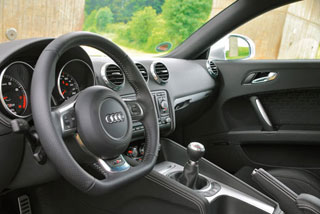 Flame motor
Flame motor Germany is an outlet for drivers. We wait for the sign to the end of the speed limit, we divert the S and the accelerator pedal. Erasa growls and breaks forward. It seems that it does not matter to the car with which transmission to accelerate. When accelerating from 180 to 220 km/h, the body imprints in a chair. The situation is repeated on V and VI gear. The frantic speed is not felt. The level of calm-as behind the wheel of an average golf-class car for 140-150 km/h.
The German owes its explosive character to a new high -speed engine that extracts 340 hp. Of their 2480 cubic meters. cm volume. Peak power is achieved in the range from 5400 to 6500 rpm. The maximum torque of 450 nm at your disposal is already at 1600 rpm and is supported to 5300 rpm.
The five -cylinder engine is unusual in its concept. Inflammation of the working mixture occurs alternately in two neighboring cylinders and two remote ones from each other. Hence the unique motor rhythm, reinforced by the geometry of the intake and exhaust manifold. Finally, a 2.5-liter TFSI is very compact and light. Its 183 kg allow you to reduce the total mass and improve the weight of the axes. The average fuel consumption is only 9.2 liters per 100 km. This is on paper and with an explosive character of Erasa calmly driving. In our case, at an average speed of 140 km/h, the consumption was about 15 l/100 km. Agree, it’s not bad for a car that accelerates to hundreds for 4.6 s.
To match the sports motor and brakes: 4-piston calipers with RS logo are digging into ventilated brake discs (with a diameter of 370 mm in front and 310 mm from behind) with a grip of the bull terrier. Slowing is effective and easily dosing, in fact, at any speed. In order for the heat to scatter faster, the front disks are perforated.
Zolder's rings
The experience of radical heating of the brakes and erasing rubber was gained on a racing highway in the Belgian Zolder. This track (80 km west of Brussels) is often mentioned in connection with the death of Formula 1 of the Gilles Vilnev in 1982. The track looks compact, but at the same time insidious, reprising with steep turns. Currently, races of younger ring series are held here. We happened to wrap about five circles on the track. And with each new ring, confidence in the car increased. The border of braking in front of the obstacles was pushed away, the screens of the tires and the echoes of blood to the head on the bends became normal. We managed to send Eras to a controlled skid with great difficulty and not on the first attempt. The car invariably rested with all the wheels even with the ESP disconnected. The case is in the branded system of the Quattro all -wheel drive, which gives the lion's share of the wheels with the best adhesion to the road. In practice, this meant that it was not necessary to fight for contact with the road surface in a quick turn.
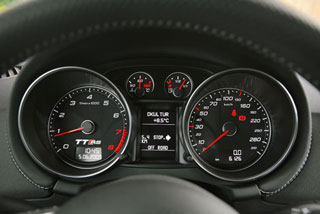 Premium sport
Premium sport Does the above mean that the balance between sports and comfort is shifted in the case of TT RS in favor of the first? Not at all. The car balances on the verge of exception and premium like a skillful canine. TT RS does not put the brand lovers before a difficult choice. He offers everything at once. Erasa’s dual nature is already illustrated by a set of standard and options. The combination of devices informs about the pressure of boost and oil temperature. There is a racing timer with which the driver can find out the time of passing the race. At the same time, the navigator screen can operate in TV mode (disconnecting when moving), and the seats -skeletons with heating. On the sports steering wheel, the Audi Concert Hi-Fi Audi-Audiosystem controls are located. The portrait of a potential buyer is thus easy to imagine. Fans of luxury, speed and style can already make orders. In Europe, the price will be 55,800 euros per compartment, Roger will cost about 3,000 euros more.
Technical characteristics Audi TT RS Coupe 2.5 TFSI MT6 Quattro
Dimensions, mm 4198x1842x1342
Base, mm 2468
Equipped mass, kg 1450
Trunk volume, l 290
Benzine engine type L5
Working volume, cubic meter. cm 2480
Max. Power, L.S./rpm 340/5400-6500
Max. moment, nm/rpm 450/1600-5300
Mechanical transmission 6-speed
The drive is complete
Max. Speed, km/h 250
Acceleration time 0-100 km, with 4.6
Fuel consumption (average), l/100 km 9.2
Tank volume, l 60
Vasily Sergeev
Photo by the author and the manufacturer
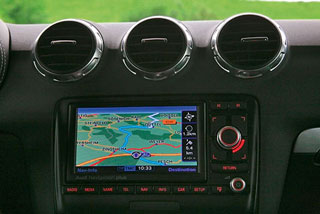
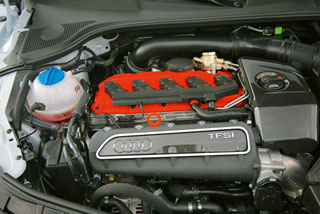
Source: Avtopanorama magazine

